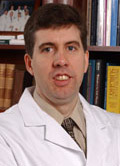Cancer cells are sick, but they keep growing because they don’t react to internal signals urging them to die. Now researchers at Washington University School of Medicine in St. Louis have found an efficient way to get a messenger into cancer cells that forces them to respond to death signals. And they did it using one of the most sinister pathogens around — HIV.

“HIV knows how to insert itself into many different types of cells,” says senior author William G. Hawkins, M.D., assistant professor of surgery and a member of the Siteman Cancer Center at the School of Medicine and Barnes-Jewish Hospital. “A portion of the HIV protein called TAT can transport biologically active compounds into cells. TAT is small, but it can move massive molecules. You could almost hook TAT up to a train, and TAT would drag it inside a cell. So we’ve taken advantage of this ability.”
In an article published online in January 2007 in the Annals of Surgical Oncology, the researchers describe using TAT to pull a protein called Bim into cancer cells. TAT alone cannot cause AIDS and has no adverse health effects. Bim acts as a tumor suppressor and causes cancer cells to die through apoptosis, a process by which cells “commit suicide.”
The research team found that the TAT-Bim compound activated apoptosis mechanisms in cancer cells and augmented the cell-killing effect of radiation. When mice with malignant tumors were treated with TAT-Bim, their tumors shrank, and they survived longer than mice that didn’t get the treatment. After 40 days, 80 percent of mice receiving TAT-Bim were alive compared to 20 percent of mice that didn’t get the treatment.
Hawkins asserts that this success marks the beginning of a very promising new approach to cancer therapy. “This is the tip of the iceberg,” he says. “Now that we’ve proven we can do this, we’ve started creating a battery of proteins that can push cancer cells to die.”

Hawkins says he thinks treatments that activate apoptosis mechanisms could provide new options for patients with the deadliest cancers — such as pancreatic cancer — which have very low rates of survival. He says he believes that clinical trials of these compounds could be just a few years away.
Hawkins began researching TAT-Bim after discussions with co-author Richard S. Hotchkiss, M.D., professor of anesthesiology, medicine and surgery and associate professor of molecular biology and pharmacology. Hotchkiss was seeking proteins that inhibit apoptosis in patients with life-threatening infections and found that TAT-Bim had the unwanted effect of increasing cell death. Hawkins wondered if TAT-Bim could be effective against cancer, and a productive scientific collaboration began between their labs to exploit the anticancer potential of TAT-Bim.
“Unlike most healthy cells, cancer cells grow very fast. So they are always on the verge of running out of natural ingredients like sugars, and mistakes are accumulating in their DNA,” Hawkins says. “This results in signals telling cancer cells to die, but the cells don’t quite have the permission they need to do it. Proteins like TAT-Bim can tip the balance in favor of death.”
To further enhance the cancer-killing power of TAT-Bim and similar proteins under development, Hawkins and his colleagues are working on a technique that will concentrate them within tumors while sparing healthy cells. In collaboration with Robert H. Mach, Ph.D. professor of radiology, they are linking the anticancer proteins to tracer molecules that selectively bind to cancer cells.
“Dr. Mach designed tracers to visualize cancer in PET (positron emission tomography) scans,” Hawkins says. “By binding our molecules to the tracers, we can deliver them to cancer cells. We’ve seen phenomenal results in the lab.”
Next Hawkins plans to combine pro-apoptotic proteins such as TAT-Bim with chemotherapy, radiation therapy and other anticancer therapeutics in hopes of further increasing cell-suicide signals within cancer cells.
Kashiwagi H, McDunn JE, Goedegebuure PS, Gaffney MC, Chang K, Trinkhaus K, Piwnica-Worms D, Hotchkiss RS, Hawkins WG. TAT-Bim induces extensive apoptosis in cancer cells. Annals of Surgical Oncology Jan 6, 2007 (advance online publication).
Funding from the Barnes-Jewish Hospital Foundation supported this research.
Washington University School of Medicine’s full-time and volunteer faculty physicians also are the medical staff of Barnes-Jewish and St. Louis Children’s hospitals. The School of Medicine is one of the leading medical research, teaching and patient care institutions in the nation, currently ranked fourth in the nation by U.S. News & World Report. Through its affiliations with Barnes-Jewish and St. Louis Children’s hospitals, the School of Medicine is linked to BJC HealthCare.
Siteman Cancer Center is the only NCI-designated Comprehensive Cancer Center within a 240-mile radius of St. Louis. Siteman Cancer Center is composed of the combined cancer research and treatment programs of Barnes-Jewish Hospital and Washington University School of Medicine.